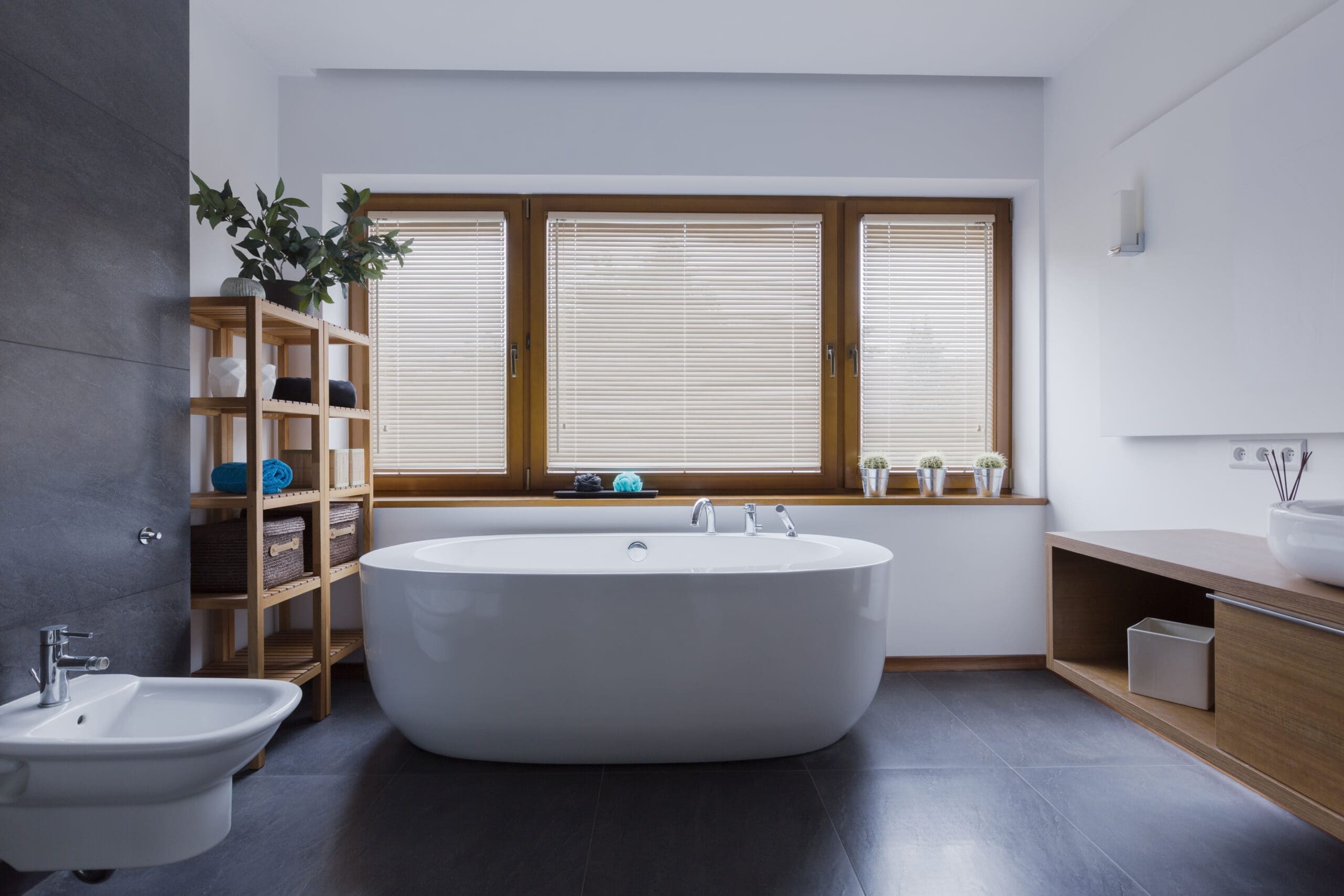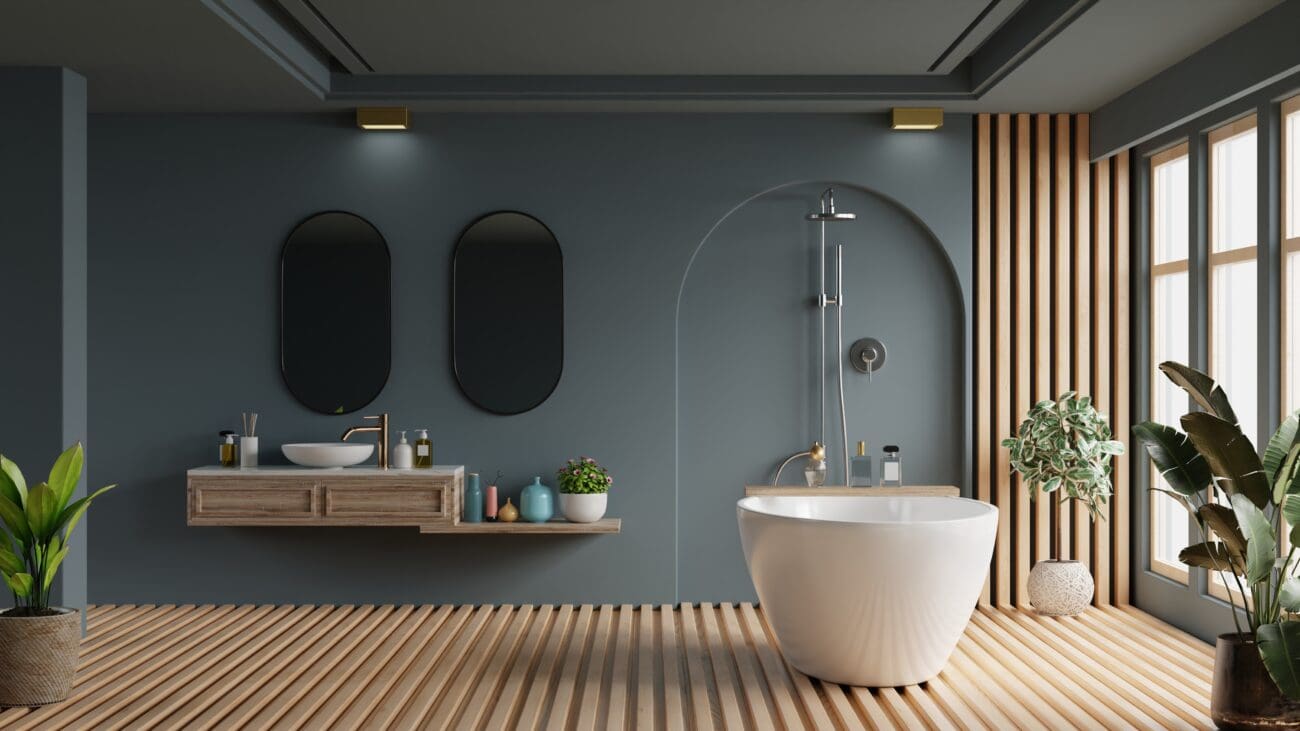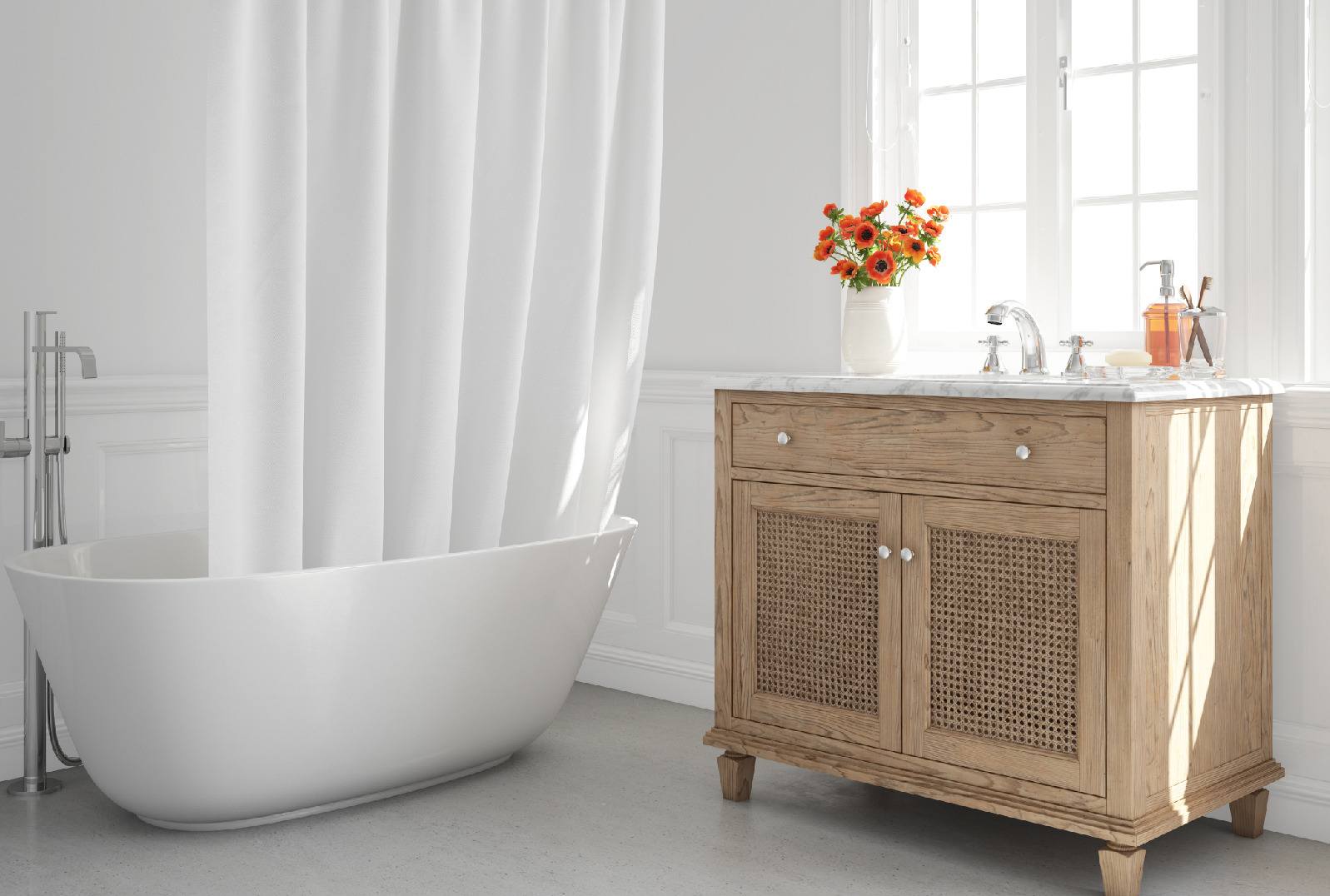Adding to the challenge is the fact that most bathrooms tend to be small, which means that it’s essential to use the available space wisely to create a stylish and comfortable environment that includes all of the desired features. Installing a bathroom can be deceptively difficult, as it requires a range of technical skills, such as plumbing and intricate spatial design.
To make the process easier and ensure that you achieve the desired results, it’s a good idea to consider enlisting the help of a design service. This could include an interior designer, a specialist bathroom designer, or even an experienced builder or plumber with an eye for design. By having access to a range of inspirational bathroom ideas and the guidance of a professional, you can create a bathroom that not only looks great but also functions efficiently.
How To Design A Bathroom
When it comes to designing a bathroom, it’s important to give it some thought, much like planning a kitchen. Start by analyzing how you currently use your bathroom, taking note of what works and what doesn’t. Look at pictures of bathrooms for inspiration and make a wish list that considers all potential users and their individual needs, as well as any future changes that may occur.
For example, a family bathroom typically needs to have a bath and surfaces that are hardwearing and splash-proof, while a master bathroom or en-suite can afford to have a more luxurious feel. Remember to think about the practicalities, as well as the aesthetics of the space


How Do You Plan A New Bathroom Layout?
When planning a new bathroom layout, it’s important to start by measuring the space accurately, taking into consideration the location of existing plumbing and electrical points, windows, and doors. Then, you can explore different layout options, such as a traditional layout with a separate bath and shower, a compact layout with a combined bath and shower, or a wet room layout with no separation between the shower and the rest of the bathroom.
Consider the flow of the room and make sure there is enough space to move around comfortably. You may also want to consider storage options, such as built-in shelves or cabinets, to maximize the use of space.
It can be helpful to create a floor plan to visualize the layout and ensure that the design meets your needs and preferences. You may want to consult with a professional bathroom designer or contractor for additional guidance and advice on optimizing the space for your specific needs.
Let’s start with the design effects that a good bathroom layout can create:
When planning your bathroom layout, it’s important to consider the view upon entrance. You want to create a welcoming and appealing visual experience for anyone entering the space. Ideally, the first thing that catches your eye should be the main feature of the bathroom, such as the bath or basin, rather than the toilet. This will help to create a more relaxing and visually pleasing environment.
Instead of designing your bathroom layout around several different features, it’s often helpful to choose one key piece as the focal point and then build the rest of the layout around it. This could be a freestanding bathtub, a stunning vanity unit, or a beautifully tiled shower area. By choosing one feature to focus on, you can ensure that the layout is harmonious and visually appealing.
If the room has symmetrical proportions or architectural features, consider a symmetrical bathroom layout. Aligning the layout with an original sash window, for example, can add a touch of elegance to the design. Symmetrical layouts can create a balanced and harmonious feel to the room, and can be especially effective in larger bathrooms.
Creating space is an important consideration when planning your bathroom layout. Make sure there is enough space around each fitting to allow for comfortable use, and pay attention to the swing of shower doors. In a smaller bathroom, you may want to consider inward-opening doors or an over-bath shower to maximize space.
Consulting with experts can certainly help in planning a well-designed and functional bathroom, especially if you’re dealing with a small or challenging space. Professionals such as interior designers, bathroom designers, builders, plumbers, and product specialists can provide valuable insights and expertise that can help you optimize your layout, choose the right products and materials, and manage your project effectively. So, don’t hesitate to ask for their advice and guidance to help you achieve your dream bathroom.
To create a more dramatic effect in larger bathrooms, it’s important to avoid placing everything along the walls. Instead, try experimenting with angles to add interest and dimension to the space. For example, consider placing an offset bath, which can add a dynamic element to the room. Another option is to bring the bath forward and incorporate a walk-in shower idea behind it, which can create an interesting and functional feature in the bathroom. By incorporating these design elements, you can make your larger bathroom feel more unique and engaging.
Check the article of Bathroom interior designs – with pictures, the best bathroom interiors


The layout of the bathroom is determined by the position of the soil stack pipe for the WC and the possibility of moving it. Relocating a toilet may require significant effort since the ideal is to have minimal bends in the toilet’s pipework to avoid blockages.
If moving the toilet, it is easier to follow the direction of the floor joists, and another option is to drill a new hole through the wall and connect into the soil stack externally. Once the toilet’s position is determined, you can plan where the basin, bath, and shower will go. Repositioning pipework is more flexible, and you can also install a new raised floor with enough depth for pipes below.
After you have determined the layout and measurements, you can start creating your mood boards and choose your products. When selecting your products, don’t forget about towel rails and heating, as one common mistake is to have to walk across the bathroom to reach a towel after leaving the shower
How To Design A Family Bathroom
In addition to slip-resistant porcelain tiles, it may also be worth considering durable and moisture-resistant paint finishes or wall coverings, such as vinyl wallpaper or fiberglass-reinforced panels.
When it comes to storage, consider built-in shelves, cabinets or drawers that can accommodate different items and keep them out of sight.
In terms of the shower-bath option, look for a design that offers both a spacious shower area and a comfortable, full-size bathtub. There are various options available, from L-shaped or P-shaped shower baths to corner or alcove designs.
Finally, make sure to choose fixtures and fittings that are easy to clean and maintain, such as chrome or stainless steel faucets and showerheads.




How To Design A Master En Suite
It’s worth noting that some people may prefer a bit more privacy and separation between the bedroom and bathroom, so this option may not work for everyone. Additionally, if you’re planning on selling your home in the future, potential buyers may be put off by a bathroom in the bedroom. It’s always important to consider your individual needs and preferences, as well as any potential future implications, when making design decisions for your home.
Planning Shower Rooms, Wet Rooms And Guest En-Suites
It’s also worth considering the shower head position and type. “A shower head that is too high can cause the water to cascade down over the shower screen or door, causing leaks and potential damage to the bathroom,”
“A large rain shower head can create a luxurious feel but can also cause splashing and the water pattern can be quite difficult to control. A hand-held shower, on the other hand, can be much more versatile, allowing the user to direct the water flow where they need it.”
In terms of design, smaller shower rooms can benefit from using larger format tiles, which can create the illusion of a larger space. Additionally, a glass shower screen can help to visually open up the space, while allowing light to flow throughout the room.
Pick The Perfect Bath
It’s worth noting that while freestanding stone, composite, and cast-iron baths may offer certain benefits, they can also be considerably heavier and more difficult to install than steel and acrylic tubs. In addition, they may require additional structural support and may not be suitable for all bathrooms. It’s important to carefully consider the practicalities and limitations of each option when selecting a bath for your bathroom.
Find The Best Brassware
That’s a great point. It’s important to consider the water pressure in your property before selecting your bathroom brassware. If you have low water pressure, you may need to opt for a showerhead with a smaller diameter and fewer nozzles, or choose a shower pump to increase the water flow. Conversely, if you have high water pressure, you’ll want to select brassware that can handle that level of pressure without causing excessive noise or damage to your plumbing. A qualified plumber or bathroom designer can help you select the right brassware for your needs.


Prioritize Bathroom Lighting At Planning Stage
Smart bathroom lighting ideas can have a massive impact on the end result and should be planned at an early stage to ensure all key fittings are illuminated properly.
we emphasizes the importance of good lighting in a bathroom, which can have a significant impact on the overall feel of the space. With the right lighting, a small bathroom can be made to look larger, and a large bathroom can feel more intimate. The choice of lighting should be tailored to the specific needs of the bathroom and its users.
Yes, using multiple layers of lighting can help create different moods and levels of brightness in a bathroom. Dimmers and separate circuits allow for more control over the lighting, so you can adjust it to the task at hand, whether it’s grooming, relaxing, or just moving around the space. This can also help save energy and prolong the life of your light fixtures by using them at lower levels when brighter light is not needed.
we also emphasizing that the lighting scheme should be planned early on in the bathroom design process. we also suggests avoiding relying too heavily on downlights, which can give a clinical look to the room, and instead using more inventive feature lighting to create a warm and inviting atmosphere.
we suggest that downlights can give a cold and sterile feel to a bathroom, which may not be the desired effect. While they are useful for providing an even coverage of light, it’s important to balance this with other types of lighting that can add warmth and character to the space.
Having multiple lighting circuits that serve different purposes is a great way to achieve a balanced lighting scheme in a bathroom. Task lighting, such as downlights, can be used in areas where it is important to have bright and even illumination, such as the shower and vanity areas. Ambient lighting, on the other hand, can help create a relaxing and comfortable atmosphere around the bath and in alcoves and niches.
Smart lighting controls, such as those offered by Crestron’s Pyng™ system, can make it easy to adjust the lighting levels and switch between different lighting scenes that are pre-programmed for different times of the day or activities. This can be especially useful in bathrooms where multiple people have different lighting preferences or when the bathroom is used for different purposes, such as getting ready in the morning or winding down in the evening.
Wireless lighting controls are a convenient way to control your bathroom lighting. These systems can be installed without cables and can include control of other features in your home, such as thermostats, security, and audio. With pre-programmed lighting scenes, you can set the mood in your bathroom at different times of the day or for different activities, such as cleaning or relaxing. This can help you create a more enjoyable and functional bathroom space
Achieve Beautiful Bathroom Flooring
Porcelain, natural stone, terracotta, and encaustic bathroom tiles are all great options for bathroom flooring. However, it’s important to consider both the aesthetic and practical aspects when choosing bathroom tiles. the flooring material should be suitable for repeated contact with water, which may make certain materials, such as wood flooring, unsuitable as they may warp and stain.
Porcelain tiles are a popular choice as they are durable, non-porous, and come in a wide range of styles and finishes. Natural stone tiles, such as marble, granite, and limestone, offer a luxurious and timeless look but may require more maintenance. Terracotta tiles provide a warm and rustic feel and are ideal for creating a Mediterranean or Spanish-style bathroom. Encaustic tiles are a trendy option that allows for intricate patterns and bold designs.
Ultimately, the choice of bathroom tiles will depend on personal preference, budget, and the overall design of the bathroom.
Ensure offering the space For Bathroom Storage
Planning bathroom storage at the early stages of a project is essential to ensure that you have the right amount of storage space and it is arranged to meet your specific requirements. Bespoke joinery can be an excellent option to create a tailored storage solution that fits your space and style. For example, a small shower room can benefit from a vanity unit wrapped in tongue-and-groove panelling to match the wall and built to the same height, making it look less obtrusive.
Will An Extra Bathroom Add Value To Your Home?
Adding an extra bathroom can certainly add value to a home, and it can also be a convenient and practical addition for busy households. There are a variety of options for adding an extra bathroom, such as converting a small adjacent room into an en suite or using stud walls to create a new bathroom within an existing space. Downstairs utility or cloakroom areas can also be a good option for adding a shower room if there are no options upstairs. Electric showers and macerators have made it easier to add bathrooms in spaces that may not have been suitable in the past, although macerators can be noisier than traditional drainage systems. It’s important to consider the plumbing and location of the new bathroom to minimize costs and ensure the project goes smoothly.
What Makes A Good Bathroom?
Absolutely, the design and functionality of a good bathroom can vary greatly depending on individual needs and preferences. The size and layout of the space, as well as the number of people using it, will also be important considerations. Some people may prefer a spa-like atmosphere with a luxurious soaking tub and plenty of space for relaxation, while others may prioritize practical features like ample storage and a large shower. Lighting is also crucial for creating the right ambiance, while storage is important for keeping the space organized and clutter-free. Ultimately, a good bathroom design should be tailored to meet the needs of the people who will be using it.



